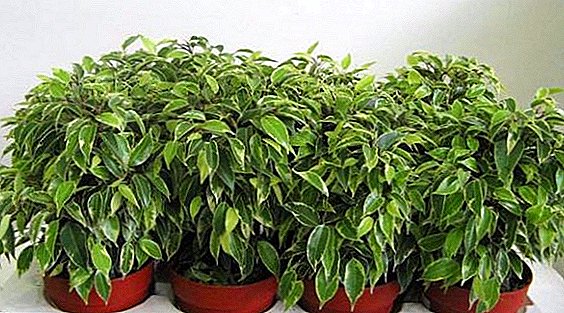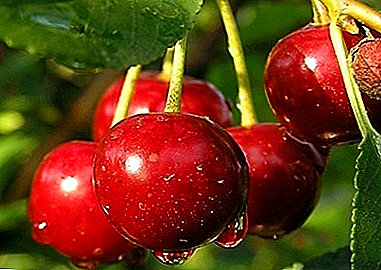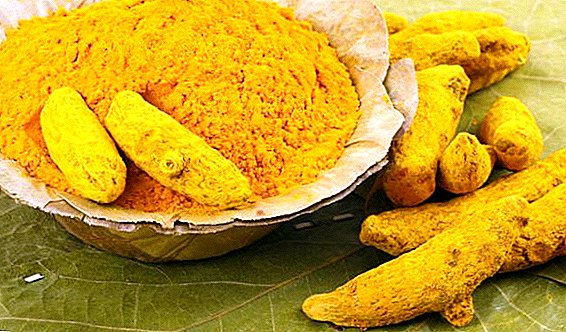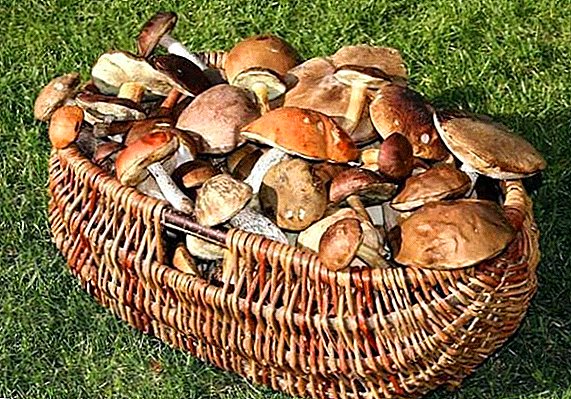 Japanese Sophora is a very beautiful and big tree with flowers similar to acacia. The tree has not only decorative qualities, but also useful healing properties. We learn in more detail how Sophora is used in traditional medicine and cosmetology, on methods of growing and preparing raw materials.
Japanese Sophora is a very beautiful and big tree with flowers similar to acacia. The tree has not only decorative qualities, but also useful healing properties. We learn in more detail how Sophora is used in traditional medicine and cosmetology, on methods of growing and preparing raw materials.
Botanical description
The height of the Sophora tree can exceed 25 m, it has a powerful root system and a wide crown. The tree belongs to the legume family. The Sophora is rather branched with unpaved, oblong leaves in the shape of an ellipse. Blossoms fragrant, white with a yellow tinge of flowers that are very similar to acacia buds. The flowering period is July-August, once every two years. Fruits-beans have a cylindrical slightly constricted shape, thickened to the base, from 3 to 8 cm long. As they mature, they change the shade from green to reddish. In one fruit 4-6 seeds of dark color ripen. Bean ripening period - September-October.
Fruits-beans have a cylindrical slightly constricted shape, thickened to the base, from 3 to 8 cm long. As they mature, they change the shade from green to reddish. In one fruit 4-6 seeds of dark color ripen. Bean ripening period - September-October.
Chemical composition
The composition of Sophora is very rich, includes a number of trace elements: calcium, potassium, iron, magnesium, iodine, zinc, boron. This tree is famous for its flavonoids and alkaloids useful for the human body, fatty oils and organic acids, glycosides. A significant amount of protein, vitamin C and essential oils are found in fruits, seeds, flowers and leaves of the tree.
Did you know? Japanese Sophora contains a record amount of flavonoid rutin and glycosides, which have a positive effect on health. Rutin strengthens blood vessels, improves the composition of the blood, has a beneficial effect on the heart.
Use: medicinal properties
The rich composition of various chemical elements makes Sophora a healing plant. The most useful are the flowers and fruits of the tree. From them prepare tinctures and decoctions. Rutin (vitamin P) is especially widely used for the treatment and prevention of diseases of the cardiovascular system, allergies, rheumatism, and infectious diseases. This substance perfectly strengthens fragile capillaries and improves the body's absorption of vitamin C. Tincture of the fruit endowed with antibacterial properties and is often used for healing wounds and ulcers. 
Japanese Sophora Application
The valuable composition, the active substances of the Japanese Sophora are widely used in traditional and traditional medicine and as a useful cosmetic tool. Most often for the preparation of medicinal and cosmetic products used flowers, fruits and seeds of plants, in some cases, the leaves. The buds contain a huge amount of rutin, and the green leaves contain a lot of vitamin C. The seeds contain valuable fatty oils.
Check out the Top 12 of the most beautiful flowering trees.
In folk medicine: what treats
Traditional medicine suggests the use of infusions, tinctures and therapeutic ointments for external use in the treatment of trophic ulcers, burns, purulent wounds, bedsores. Many traditional healers recommend the use of drugs on the basis of Sophora in diabetes mellitus, liver diseases, angina, internal bleeding, with disorders of the stomach and intestines, atherosclerosis, thrombophlebitis, rheumatism, deprive.  Also used as a tonic, rhinitis is treated by instillation of an aqueous solution of Sophora tincture into the nose. Baths help to get rid of fungal skin lesions and nails. Tinctures are used externally to treat lupus erythematosus, psoriasis, and skin tuberculosis.
Also used as a tonic, rhinitis is treated by instillation of an aqueous solution of Sophora tincture into the nose. Baths help to get rid of fungal skin lesions and nails. Tinctures are used externally to treat lupus erythematosus, psoriasis, and skin tuberculosis.
Important! The unique composition of Sophora helps to cure diseases of the female reproductive system, reduces unpleasant symptoms of menopause.In hypertension, traditional medicine recommends Sophora for internal use. A solution based on this plant is used to rinse the mouth and relieve inflammation of the gums, treat gingivitis and stomatitis. Sophora medications help prevent baldness.
In cosmetology
Japanese Sophora has also been used in cosmetology as an excellent tonic to preserve youthful skin and reduce inflammation. Fatty oils, vitamins and minerals have a beneficial effect on the sebaceous glands, moisturize and nourish the skin, reduce and cleanse the pores. Useful herbal ingredients are added to skin and hair care products, shampoos, balms, lipsticks, creams and lotions.  The nourishing and vitamin composition of Sophora has a beneficial effect on the health of the hair, strengthens the bulbs, eliminates dandruff, and normalizes the work of the sebaceous glands. Sophora-based creams are excellent for skin care, moisturize, heal small cracks and sores, have a rejuvenating effect. Many Japanese Sophora-based cosmetics are suitable for the care of problem skin and skin with high fat content, enlarged pores.
The nourishing and vitamin composition of Sophora has a beneficial effect on the health of the hair, strengthens the bulbs, eliminates dandruff, and normalizes the work of the sebaceous glands. Sophora-based creams are excellent for skin care, moisturize, heal small cracks and sores, have a rejuvenating effect. Many Japanese Sophora-based cosmetics are suitable for the care of problem skin and skin with high fat content, enlarged pores.
Did you know? Sophora is a symbol of Beijing. The magnificent tree adorns the botanical gardens and parks not only in China and Japan, but also in the Crimea, the Caucasus and Central Asia.
Harm and contraindications
Despite its many beneficial properties, Sophora-based medicines can cause harm. The first contraindications relate to pregnant and lactating women, children up to 3 years. The rich composition of active biological and chemical substances can cause allergic reactions and disruption of the organs and systems in the body. At risk are people with diseases of the liver, kidneys and blood vessels.
Marigold, honeysuckle and white acacia is contraindicated for pregnant women.Long-term intake or excess doses may lead to the fact that the body accumulates too much of rutin. Symptoms are disorders of the gastrointestinal tract, nausea, diarrhea, vomiting, flatulence. In this case, you must stop taking the drug. It is important that any doctor based on Sophora be prescribed by a doctor with recommendations for dosage and on the basis of analyzes. Self-medication is unacceptable.

How to cook at home, how to take
Do not make much effort to prepare the infusion or infusion Sophora independently at home. The raw materials used are the buds and fruits of the tree, in them the greatest concentration of valuable substances.
Tincture
For the preparation of tincture need buds Sophora and vodka.
- Buds (100 g) chop and pour vodka (0.75 l) in a glass container, place the dishes in a dark place. After 10 days, filter. The tincture is recommended for use in diseases of the blood vessels and the heart for 1 teaspoon three times a day, half an hour before meals.
- The second recipe is made from chopped fruit, pouring them with alcohol in a ratio of 1: 1 for fresh fruits, and in a ratio of 1: 2 for dry ones. It is necessary to maintain the tincture in a sealed container in a place protected from the sun for 20 days. It is recommended to apply the prepared tincture every four hours, 10 drops for a month, and then 40 drops for up to six months. This tincture helps to lower blood pressure, improve cerebral circulation, especially after a stroke.
 A compress on the back of the head for the night from a tincture diluted with water in a ratio of 1: 3 helps well from hypertension. In order not to burn the skin, you must first apply a little baby cream, and then apply a compress. Tincture can rub the sore back and joints for three weeks.
A compress on the back of the head for the night from a tincture diluted with water in a ratio of 1: 3 helps well from hypertension. In order not to burn the skin, you must first apply a little baby cream, and then apply a compress. Tincture can rub the sore back and joints for three weeks.Infusion
To prepare the infusion, you must place the crushed fruits of the Sophora in a glass dish and pour boiling water over it. Per 100 grams of fruit will need 1 liter of water. Insist 12 hours, then bring to a boil. After cooling, strain and rub the mass through a sieve. Connect the infusion with mashed mass and place in a cold place, you can refrigerate. Such an infusion can be taken orally 30 ml three times a day, an hour after eating as a laxative.
Infusion can be prepared from saxifrage, goldenrod, dogrose, nasturtium, hazel, groundweed, thistle, mordovnik, ash, autumn crocus and heather.Water infusion can be used for gargling and rinsing the nose with SARS. Another recipe is made from fresh flowers. You need 20 g of crushed flowers pour 200 ml of boiling water. After 2 hours, you can strain and take 1 tbsp. spoon after meals, three times a day. Used to treat diseases of the stomachs and intestines. Also in the complex therapy treats the liver, atherosclerosis, diabetes mellitus, angina and internal bleeding.

Growing up
Sophora is a very wide and large tree that loves the sun and warmth. But it can be grown not only in an open area, but also at home, in an apartment or office. Decorative tree can decorate any interior.
Important! The tree can be grown from seeds or cuttings. Before planting, seeds should be soaked in warm water for 12 hours. The young stalk is also covered, creating a greenhouse effect.
Choice of location and lighting
The tree loves bright sunshine, it’s necessary to choose a place on the east and south side not far from the windows or on the windowsill. If the lighting is not enough, then you need to install fitolampy. At noon you can shade a little tree, protecting it from ultraviolet radiation. If possible, in spring and summer it is advisable to carry the plant pot to fresh air. 
Substrate, soil and fertilizer
There are no special recommendations on the choice of soil quality, the tree is quite unpretentious. The main thing is that the soil is well let in air and moisture. The tree can grow even in very poor soil, as it independently produces nitrogen by the root system, creating a symbiosis with some bacteria.
Grow sakura, delonix, wisteria, albition, rhododendron, cassia, magnolia and pyracantha at home.The substrate can be prepared from a mixture of sand, compost, ash and soil. At the bottom of the pot must create a drainage. Fertilizers must be applied during the active growing season twice a month, organic fertilizers can be alternated with mineral fertilizers.
Content temperature
The tree does not like high temperatures in autumn and winter. The optimum temperature during this period is from 0 to +13 ° C. If you do not have the opportunity to create such conditions for him, then do not worry, it will not die at room temperature. Additional lighting in the autumn-winter period is not required. 
Humidity and watering
Sophora feels great in a dry climate, it does not need to be sprayed. It is impossible to water frequently and plentifully, in winter, at low temperatures, it is sufficient to do this once every two weeks, and at room temperatures - once a week. There are no special water requirements, even hard water will be suitable for irrigation. With insufficient moisture, the leaves will dry out and fall off.
Wintering period
With the beginning of autumn the leaves gradually turn yellow and fly around, the tree begins to prepare for winter. If it winters indoors, part of the foliage remains. When kept in a cold place, the foliage falls off completely. During this period, there is no need for frequent watering. With the increase in daylight in February, the process of awakening begins, buds appear. It is necessary to fertilize the plant and increase the frequency of watering. 
Transfer
Transplantation is sufficient to hold every two years. It is necessary to transplant in a large pot only young plants in the period of the beginning of intensive growth. It is not necessary to replant large trees, it is necessary to pour a new substrate and change the top layer of soil in a pot. The most favorable period for transplantation is the beginning of spring, when the plant awakens after wintering.
Procurement of raw materials and storage conditions
The buds are harvested in the morning, after the dew has dried, dried in well ventilated rooms or dryers at a temperature of + 35 ... +45 ° C. From time to time in the drying process it is necessary to mix the raw materials. Fruits are collected in light green, not quite ripe, as soon as the seeds began to darken. Dry at + 20 ... +35 ° С. Dried buds and fruits should be stored in a dry container in a dark place.  Raw materials can be stored without losing their properties, up to one year. These are the features of growing and useful properties of this interesting ornamental and medicinal plants. If you wish, you can grow a sophora even in your apartment; it will not only create a beautiful green corner, but also provide useful raw materials from which you can prepare healing products and use them in cosmetology.
Raw materials can be stored without losing their properties, up to one year. These are the features of growing and useful properties of this interesting ornamental and medicinal plants. If you wish, you can grow a sophora even in your apartment; it will not only create a beautiful green corner, but also provide useful raw materials from which you can prepare healing products and use them in cosmetology.
Reviews from the network














